Some Kinetoscope Films
of G. W. Bitzer
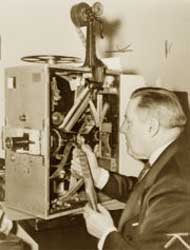 G. W. Bitzer (1872-1944), as cameraman to D. W. Griffith, was the greatest cinematographer of the silent era, the eye behind the camera on such films as Broken Blossoms (1919), Birth of a Nation (1915), & Intolerance (1916).
G. W. Bitzer (1872-1944), as cameraman to D. W. Griffith, was the greatest cinematographer of the silent era, the eye behind the camera on such films as Broken Blossoms (1919), Birth of a Nation (1915), & Intolerance (1916).
Billy Bitzer's filmmaking career spanned the whole of the silent era, beginning with the earliest days of the kinetoscope & mutoscope.
In that pioneering era for cinema, he was cameraman on scores of short-short films, commonly with no producer other than himself, making him defacto director as it would later be defined. Elsetimes he worked with such leading proto-directors of the kinescopic era as J. Stuart Blackton, William K. L. Dickson, & Wallace McCutcheon.
The following short films are some of the ones for which Billy had primary creative control, honing his skills years before his glorious association with D. W. Griffith.
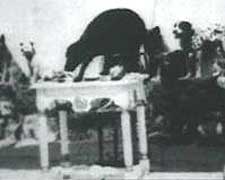 Professor Leonidas, a vaudeville performer, stages part of his dog act in Stealing a Dinner (1903). The professor is seated at a table with a dinner napkin tucked in his shirt-collar. Several dogs are sitting in the background.
Professor Leonidas, a vaudeville performer, stages part of his dog act in Stealing a Dinner (1903). The professor is seated at a table with a dinner napkin tucked in his shirt-collar. Several dogs are sitting in the background.
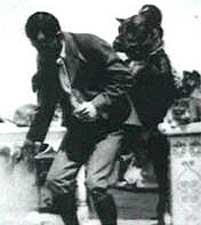 A cat leaps on the table but the professor grabs it before it steals his food, tossing it away. The professor has forgotten something or another, & leaves the table to fetch it, That's when a black lab leaps on the table & eats the dinner, while the other dogs watch attentively. A cat leaps on the table but the professor grabs it before it steals his food, tossing it away. The professor has forgotten something or another, & leaves the table to fetch it, That's when a black lab leaps on the table & eats the dinner, while the other dogs watch attentively.
The lab then jumps down, picks up the cat in his teeth, & sets the cat on the dinner table. When the professor returns, he is so angry that he draws his pistol & prepares to murder the cat.
That's not quite what the lab had in mind, so he jumps up on the table & stands on his hind legs, protecting the cat. So our luckless diner shoots the lab. At that moment a gigantic mastiff wearing a police hat & uniform jumps on the professor, arresting him for murder. It's quite an act.
It's a wonderful glilmpse of vaudeville entertainment, the professor having not only well trained animals, but a good sense of what's funny.
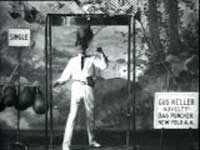 Films of vaudeville performances must've been popular in the kinescope parlors, for American Biograph & Edison Manufacturing Co. sure made a lot of them, & G. W. Bitzer was often launching yet another little film for the more unusual performers.
Films of vaudeville performances must've been popular in the kinescope parlors, for American Biograph & Edison Manufacturing Co. sure made a lot of them, & G. W. Bitzer was often launching yet another little film for the more unusual performers.
Vaudevillian Gus Keller, billed as a "novelty bag puncher," is featured in Expert Bag Punching (1903). His act is pretty darned simple, & yet extremely appealing.
The exhibition is arranged like a physical education teacher's instruction on various methods of using a punching bag. The bag is mounted on the roof of a metal frame inside which Gus stands, clad in collegiate white slax & shirt, a neat haircut -- no Joe Palooka this, but a Physical Culture promotor.
A fan is blowing from off stage, for a windsock beside the frame structure & flags on its roof are fluttering like mad. Stage right there's a sign that gives the name of the punching method being conveyed. With each dissolve into the next method, the sign changes, starting with "Single" which is how most of us would punch a bag with both fists fast as we could manage.
When it dissolves into "Knee" the bag is now off the ceiling & Gus is literally punching it with his knees & bouncing it a bit like a basketball. This dissolves into "Floor" which is a wild punching maneuver of the bag between his legs, slammed rapidly from a bowed position.
"Double" has him punching with both fists, & bouncing a second bag with his knees. "Aeriel" is a very loosely hanging bag that flies wildly about as punched.
"Triple" is punching two hanging bags, one for each fist, plus knee-punching a third. Last is "Double Floor" beating the crap out of two bags on the floor beneath his legs.
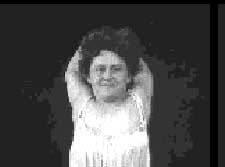 An even more unusual act is by a woman billed as Latina. She shown from the waste up in Latina, Dislocation Act (1905) shows the infamous Latina apparently or presumedly popping her arms from the shoulder sockets in order to contort herself into impossible movements.
An even more unusual act is by a woman billed as Latina. She shown from the waste up in Latina, Dislocation Act (1905) shows the infamous Latina apparently or presumedly popping her arms from the shoulder sockets in order to contort herself into impossible movements.
She then turns away from the camera so that it's possible to see her arms go back into the sockets with a quick jer. Creepy if it's for real & not just extreme limberness presented as bone dislocation.
Latina, Contortionist (1905) shows another bit of her vaudeville act, which involves bowing so completely with head to knees that she's doubled in half. She then slips a ring down the length of her folded body.
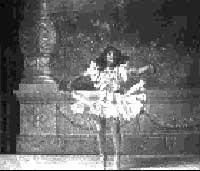 It's not that interesting an act, but when one realizes she performed for predominantly male audiences, & it's 1905, yet she's wearing far less than women would be wearing even on a beach, the real purpose of her "physical culture" act is clear. It's not that interesting an act, but when one realizes she performed for predominantly male audiences, & it's 1905, yet she's wearing far less than women would be wearing even on a beach, the real purpose of her "physical culture" act is clear.
And while considering the seedy element of mutoscope or kinetoscope peepshow films, Betsy Ross Dance (1903) is creepiest if the context is considered. It is patterned after the many sexy-dancing-girl films that were so easy to sell a penny a peek.
But this one's a little girl in flouncy dress spinning & kicking & revealing her garter, combining girl's ballet & music hall can-can moves in an antic minute & a half performance. She's assuredly older than she looks, as she was a burlesque performer known as "Little Anita."
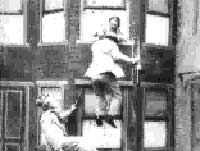 The comedy vignette Serenaders (1899) had Frederick S. Armitage assisting Billy Bitzer. Totally appalling rivals appear under a fair maiden's window to serenade her, one with a trumbone, the other with a clarinet.
The comedy vignette Serenaders (1899) had Frederick S. Armitage assisting Billy Bitzer. Totally appalling rivals appear under a fair maiden's window to serenade her, one with a trumbone, the other with a clarinet.
She appears at the second story window & doesn't seem to be nearly as alarmed as she ought to be. She shows an interest in the clown with the trumbone, so the rejected clarinetist kicks his rival in the butt.
The trumbonist flies straight up to the second story window from the mighty shoe to his trousers. The clarinet player hops about having hurt his foot.
The wooed maiden clings to the trumbone player lest he fall & get hurt. It's a funny little skit, & the flight to the second window is nicely staged.
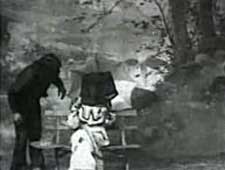 Vaudeville provided many of the on-film talent & ideas for short-short films. A Frontier Flitation; or, How the Tenderfoot Won Out (1908) is an odd three-quarters of a minute sexually burlesque comedy.
Vaudeville provided many of the on-film talent & ideas for short-short films. A Frontier Flitation; or, How the Tenderfoot Won Out (1908) is an odd three-quarters of a minute sexually burlesque comedy.
It shows a woman seated on a park bench with an exaggeratedly large veil over her entire head. A groddy mustachieoed frontiersman or cowboy begins flirting in the most horrid manner as she tries to keep his hands off her.
The homely cowboy eventually lifts the veil then takes off running when he sees her hideous monkey-face. But it's only a mask, which is removed as the young woman's boyfriend appears from stage left very modernly dressed.
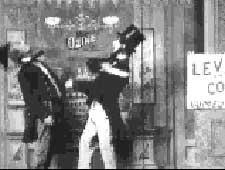 Curiously titled Levi & Cohen the Irish Comedians (1903), presumedly one of the vaudeville team's main "jokes" is that they were Jews pretending to be Irish. Their act isn't much funnier, but Billy Bitzer wasn't picky whose acts he filmed.
Curiously titled Levi & Cohen the Irish Comedians (1903), presumedly one of the vaudeville team's main "jokes" is that they were Jews pretending to be Irish. Their act isn't much funnier, but Billy Bitzer wasn't picky whose acts he filmed.
A boy in bellboy's cap comes onto the vaudeville stage to replace one sign with another, introducing the team of Levi & Cohen.
The curtain raises revealing a backdrop painting conveying a business street, & out run the comedians, one with a bowler & cane, the other with beard & tophat.
They bump into one another & an argument ensues, the chap in the tophat being especially abusive. After the more forgiving of the two has his hat knocked off for the third time, he begins to retaliate, but not as aggressively as the audience, which begins pelting the lousy comics with eggs.
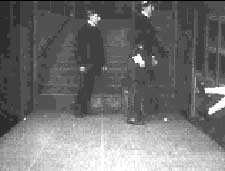 2 A.M. in the Subway (1905) shows the foot of a staircase to convey the exit of a dim lit subway, though obviously staged.
2 A.M. in the Subway (1905) shows the foot of a staircase to convey the exit of a dim lit subway, though obviously staged.
A well-dressed dandy, completely snockered, with two drunken ladies, stumble onto the platform, bumping into a weary cop. There procedes arguing & shoving & a moment of "indecent exposure" as one of the ladies lifts her dress & shows her stockings.
A man with a long thin package happens by just as the cop is getting rid of the unruly women & the guy. Shortly after the cop sees two naked legs poking around a corner into the camera frame, kicking, & he thinks the indecent woman is acting up worse than before.
Turns out the guy with the package had two maniken legs on him, or perhaps prosthetic limbs, & it's a practical joke on the cop. A pretty feeble one at that.
The staging is phony, with a camera angle showing nothing bu the staircase & only the title to inform the viewer that this is the subway.
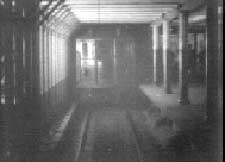 By comparison, Billy Bitzer directed, that same year, Interior New York Subway, 14th St. to 42nd St. (1905) which opens with a full location shot of a subway rolling away from the platform.
By comparison, Billy Bitzer directed, that same year, Interior New York Subway, 14th St. to 42nd St. (1905) which opens with a full location shot of a subway rolling away from the platform.
Filmed from the front of a second train, we follow the lead train as it rushes along the track in the dim, dim lighting, stopping at the next platform, then continuing on.
It's six & a half minutes of following the subway through the dark, concluding at a busy city center station, & it's quite interesting, even haunting to watch.
It's kind of too bad Billy never thought to combine just a tiny bit of this documentary footage with the vaudeville skit, in order to make it seem like it really took place on a subway platform. That's something Edwin S. Porter was already doing in films like A European Rest Cure (1904) which used beautiful footage to establish a sea cruise, then launched a series of comedy routines on stages.
copyright © by Paghat the Ratgirl
|
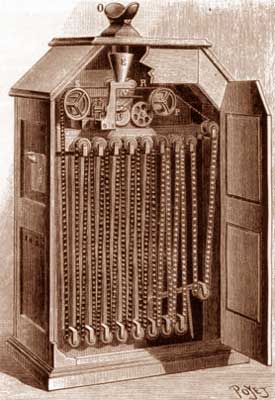
 G. W. Bitzer (1872-1944), as cameraman to D. W. Griffith, was the greatest cinematographer of the silent era, the eye behind the camera on such films as Broken Blossoms (1919), Birth of a Nation (1915), &
G. W. Bitzer (1872-1944), as cameraman to D. W. Griffith, was the greatest cinematographer of the silent era, the eye behind the camera on such films as Broken Blossoms (1919), Birth of a Nation (1915), & 
 A cat leaps on the table but the professor grabs it before it steals his food, tossing it away. The professor has forgotten something or another, & leaves the table to fetch it, That's when a black lab leaps on the table & eats the dinner, while the other dogs watch attentively.
A cat leaps on the table but the professor grabs it before it steals his food, tossing it away. The professor has forgotten something or another, & leaves the table to fetch it, That's when a black lab leaps on the table & eats the dinner, while the other dogs watch attentively.

 It's not that interesting an act, but when one realizes she performed for predominantly male audiences, & it's 1905, yet she's wearing far less than women would be wearing even on a beach, the real purpose of her "physical culture" act is clear.
It's not that interesting an act, but when one realizes she performed for predominantly male audiences, & it's 1905, yet she's wearing far less than women would be wearing even on a beach, the real purpose of her "physical culture" act is clear.



